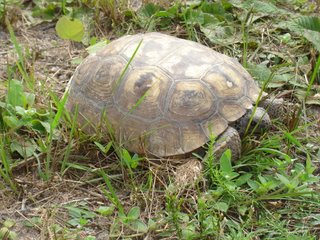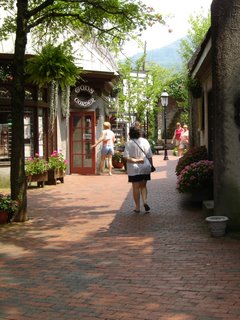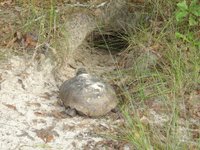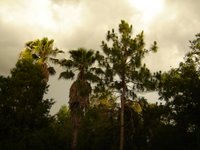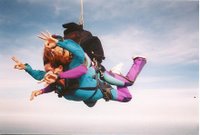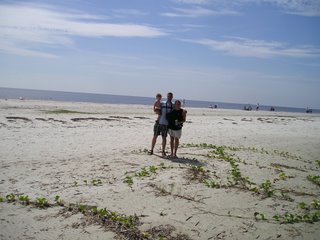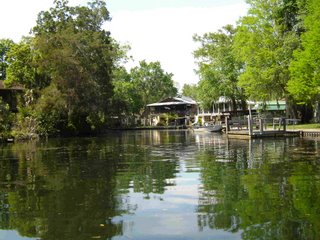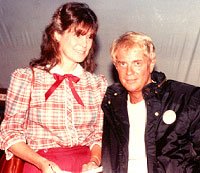Friday, December 29, 2006
BRIDGED BY LOVE
Historical novel good, fast read for any afternoon"
Bridged by Love
by Patricia Shipp Lieb
Reviewed by Bonnie Flouhouse
St, Anne, IL
Patricia Shipp Lieb's "Bridged by Love" is a historical novel set in Texarkana in the late 1880s. It's the story of two women--Shanna (a young Indian woman trying to evade ruthless white men) and Kathryn (a storng white woman willing to take on any opponent).
Several people, but most importantly an infant, tie the women's lives. The fast plot is at times too coincidental, but it ensnares the reader in the story of these women. To build suspense, the author presents segments of one character's story, stops at a crucial moment, and then moves to the other character's struggles.
Because the only way to connect Shanna and Kathryn is to show how several men are involed in their lives, several episodes involved only these men. Liberal doses of danger, treachery, intrigue, and romance fill the book. Eventually Lieb untangles everyone and brings closure to the storylines.
Numerous predictable stock characters add to the local color of the book: the slick swindler, the traveling prostitute, the ignorant guy who'll do anything for a few coins, the prejuciced business owner, the liberal man who thinks Indians are mistreated, the fiercely strong pioneer woman, the decent man who patiently waits for his chance at love, and displaced Indians. Add a ruthless tavern owner and a young man willing to face all foes for the woman he loves, and the character list is complete.
In an attempt to capture the aura and lifestyles of a past time, Lieb has crowded lost of characters and details into her book. But over all, "Bridged by Love" is a fast read good for an afternoon's enjoyment.
Bridged By Love
Trade paper back & ebook downloads from Asylett Press, Fictionwise, and any major book store.
Hardback:
by Patricia Shipp Lieb
Publisher:
Trade paperback; order from Asylett Press
Hardback 328 pages; order from Booksurge
Description: Kathryn, a backwoods woman, and the young Indian girl, Shanna, have a connection: love for an infant. Set in about 1885, give or take, on the borders of Arkansas, Louisiana and Texas, with travels to the Indian Territory (now Oklahoma), complex characters tangled with kidnapping, murder and romance add a height of tension to this suspenseful telling of the difficult roads traveled between two women bridged by love. Copyright 2006 (c) Patricia Shipp Lieb
BRIDGED BY LOVE by Patricia Lieb is published by Asylett Press
https://www.asylett.com/HTML/mainsite.htm
Saturday, November 04, 2006
Book signing in Gulfport, Mississippi
 Book signing
Book signing at Barnes & Noble
Gulfport, MS,
Patricia Lieb, author
(Murders
in the Swampland;
Bridged by Love;
and Glenn Sweman,
author of 11 books
of poetry.
author of 11 books of poetry
New Publisher for Patricia Lieb: Asylett Press
Friday, October 27, 2006
Whooooooo: the ghosts of poets
Visit the Graves of Poets
Death, Be Not Proud: The Graves of Poets
At the Academy of American Poets
http://www.poets.org/viewmedia.php/prmMID/19256
Thursday, October 26, 2006
Captured: poems by Patricia Lieb

Captured
By Patricia Lieb
Acknowledgements:
A Pteranodon chapbook published by Lieb-Schott Publications. Copyright 1983 by Patricia Lieb. All rights reserved.
Grateful acknowledgement is made to the editors and publishers of the following publications where the collection of poems in Captured first appeared:
Affinities: The South Florida Poetry Review, for Shadows and The Deep: Sirens;
Anthology of Florida Poets for Grave Digging (third printing), and Looking At You Through A Rain Covered Window Pane;
Cedar Rock for Grave Digging and Waiting;
Earthwise for Hurricane;
The Florida Arts Gazette for Captured;
Gryphon for Learning To Write A Poem;
Indian Corn for Bathing In Red Wine Words;
Pudding for Grave Digging (second printing);
The Spoon River Quarterly for Dreaming Of Wheat;
Tempest for The Eagle And The Dove;
Xarier Review for Until Dawn.
Captured by Patricia Lieb
Available from Liebbooks.com
Saturday, October 21, 2006
Monday, October 16, 2006
Thursday, October 12, 2006
Poet Jared Carter
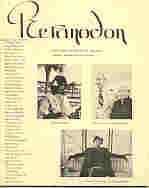
Read the impressive interview
Carol Schott Martino and I
conducted
with the awesome poet
Jared Carter back in
the days of Pteranodon.
Please leave a comment.
http://jaredcarter.com/archives/interviews/pteranodon/
The Pteranodon magazine cover shown above features numerous poets; pictured are Dr. Barbra Nightingale, professor of poetry and creative writing at Broward College in Hollywood, FL; Dr. Glenn Swentman, writer in residence at William Carey College, Gulf Port, MS; and the late poet and professor of Humanities at the University of South FL in Tampa Dr. Hans Juergensen; the bottom photo is of the famed Indiana poet Jared Carter.
Carol and I met Jared Carter in about 1979 when he was a featured speaker at the Suncoast Writer's Conference in St. Petersburg, FL., and have since attended his readings. You are in for a treat when visiting his Website (link above).
Please watch for revisits to the eight issues of the literary magazine Pteranodon featuring Jared Carter, William Stafford, Richard Eberhart, Richard Shelton and other internationally know poets and writers via <http://liebbooks.com>. We published Pteranodon in 1979-1984.
Wednesday, October 11, 2006
Wild Orchids
Sunday, October 08, 2006
Hurry Up
Sunday, September 24, 2006
Judy Candis

Judy, a very loved soul
August 8, 1950-September 18, 2006
Novelist, Writing Instructor, & Business Owner
Author of Color Blind, Blood Offering, Still Rage, & All Things Hidden
CEO of Bar-B-Que King, Incorporated
Beloved Mother, Sister, Aunt, Cousin, Niece & Friend!
http://www.judycandis.com/
http://jccafe.blogspot.com/
Photo of Judy and me at a signing for All Things Hidden in Tampa, FL
Friday, September 22, 2006
GO! Barack Obama (D) IL
http://www.barackobama.com/2004/07/27/dnc_2004.php

IL U.S. Senator
Barack Obama
has a lot to say
to those who
will listen or read.
http://www.barackobama.com/2006/09/14/louisville_dems.php
http://www.barackobama.com/2006/09/20/energy_independence.php
Tuesday, September 19, 2006
Speaking at William Carey College, Gulfport, MS
Friday, September 01, 2006
This is where I live in Florida
Saturday, August 26, 2006
Skydiving
Friday, August 25, 2006
Tuesday, August 22, 2006
From Texarkana College; KTXK Public Radio Aug. 24, 9 a.m.
Tuesday, August 15, 2006
Sadly, this is William Carey College, Gulfport, MS


William Carey College, Gulfport, MS, Aug. 1, 2006
Classes are being held in these trailers more than a year after Hurricane Katrina.
On my trip to Gulfport, MS, earlier this month to speak with Dr. Glenn Swetman's creative writing class at William Carey College, I was saddened by the disaster still plaguing the Gulf Coast, aftermath of Hurricane Katrina.
I will speak at Swetman's American Literature class on October 26, after a duel booksigning with Swetman at the Barnes & Noble in Gulfport on Oct. 25. For more information email pat@liebbooks.com
Monday, August 14, 2006
Friday, July 28, 2006
Sunday, July 09, 2006
On Writing Historical Fiction
I will talk to Dr. Glenn Swetman's Creative Writing class at William Carey College, Gulfport, MS, Aug. 1 and will sign copies of my novels "Bridged by Love" and "Across the Red River to Her Mysterious Heritage" at a local bookstore there Aug. 2. For more information e-mail me at: pat@liebbooks.com. Also in August, I will be guest author at Judy Candis' Writing the Popular Novel class at the University of South Florida in Tampa.
From Amazon. com
July 30, 2006
A great taste of the old frontier, July 30, 2006
Reviewer:
Paul S. Brittain (Scottdale, PA USA) - See all my reviews Bridged By Love was a pleasant surprise for someone whose readings usually tend to science fiction and horror. But Patricia Shipp Lieb grabbed my attention from the first page and held it throughout this well-crafted novel, weaving twists, turns and surprises. Female protagonists Shanna and Kathryn are connected through the love of baby Aaron, who is the center of this saga. Both strong in resolve, Shanna is a native American Indian and Kathryn is a frontier woman who together triumph over the schemes of a number of unscrupulous men. The author's attention to detail brought the old southwest to life as she deftly blended the passages of her many characters. I am honored to have had the opportunity to read and review this book, and highly recommend it to someone who is seeking a different kind of story that is based on a long gone historic era. I look forward as well to other readings of books by Patricia Shipp Lieb.
From the Tampa Tribune, July 9
"Bridged by Love," by Patricia Shipp Lieb (BookSurge, $16) - Spring Hill resident Lieb has written a historical adventure set in the late 1880s in Texarkana, a city that straddles the Texas-Arkansas line. Lieb draws on a bounty of historical knowledge to craft a tale of two women - one native American, the other white - linked together in a fight against injustice.
From the Daily Journal, Kankakee, IL, May 28
Historical novel good, fast read for summer afternoon
"Bridged by Love"
by Patricia Shipp Lieb
Reviewed by Bonnie Flouhouse
St, Anne, IL
Patricia Shipp Lieb's "Bridged by Love" is a historical novel set in Texarkana in the late 1880s. It's the story of two women--Shanna (a young Indian woman trying to evade ruthless white men) and Kathryn (a storng white woman willing to take on any opponent).
Several people, but most importantly an infant, tie the women's lives.
The fast plot is at times too coincidental, but it ensnares the reader in the story of these women.
To build suspense, the author presents segments of one character's story, stops at a crucial moment, and then moves to the other character's struggles.
Because the only way to connect Shanna and Kathryn is to show how several men are involed in their lives, several episodes involved only these men. Liberal doses of danger, treachery, intrigue, and romance fill the book.
Eventually Lieb untangles everyone and brings closure to the storylines. Numerous predictable stock characters add to the local color of the book: the slick swindler, the traveling prostitute, the ignorant guy who'll do anything for a few coins, the prejuciced business owner, the liberal man who thinks Indians are mistreated, the fiercely strong pioneer woman, the decent man who patiently waits for his chance at love, and displaced Indians. Add a ruthless tavern owner and a young man willing to face all foes for the woman he loves, and the character list is complete.
In an attempt to capture the aura and lifestyles of a past time, Lieb has crowded lost of characters and details into her book. But over all, "Bridged by Love" is a fast read good for a summer afternoon's enjoyment.
Back to Liebbooks.com
Bridged By Love by Patricia Shipp Lieb
Publisher: BookSurge
Pre-publication reviews for "Across the Red River to her Mysterious Heritage"
By Patricia Shipp Lieb
Review by Dr. Glenn Swetman: author, poet, writer in residence at William Carey College, Gulf Port, MS
In Across the Red River to her Mysterious Heritage, Lieb (known for her no-nonsense true crime reporting, her sensitive and complex poetry and her exceptional initiation novel, "And Her Name Was Catharine") has conceived yet another genera.
Her latest, Across the Red River to her Mysterious Heritage, is a literary triumph, a genealogical mystery novel, and a record of the acute pangs of longing that make us human. Mary, the protagonist of the book, is engaged in a search for her identity both physically and spiritually as she struggles through her own kinds of Pilgrim's Progress or Divine Comedy that takes her from the portals of Purgatory to the brink of her personal Inferno.
But not only is this a book that should be read, it is a book that is exceptionally readable.
The words seem to leap from the page to the reader's eyes and from there do the very soul: a must for the serious reader. A must for anyone who reads.
Pre-publication review by Allan MacKinnon, writer-photographer, The Florida Keys
Patricia Lieb has written a best seller! The story chronicles the search by Mary Gray, a young black woman with blue eyes, for her heritage. Each chapter grabs you and won't let you go. You'll reach for each new chapter to learn more about Mary's, until near the end of the book, you begin to get a hint of where she will find her ancestors. Well written and well conceived, Mysterious Heritage leaves you hoping that the author has more intrigging tales in the future for our enjoyment.
Pre-publication review by Dr. Barbra Nightingale, Professor of English and Creative Writing, Broward College, Hollywood, FL
Wow! Patricia is a true storyteller; each page begs to be turned as her intriguing prose spins it tale full of surprises.
Well told!
"Across the Red River to her Mysterious Heritage" can be ordered from Xlibris.com
Book signing in Dade City, FL

The Tampa Tribune
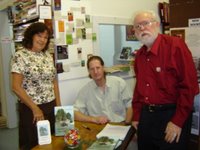
2 Authors Appearing At The Book Shack
Photo: Patricia Lieb, J. B. Preston & Dr. Glenn Swetman
Book Shack owner Jo Kassabuam (above) gets ready for another day of literature at her shop in Dade City, FL.
Dade City--Two local writers will be at The Book Shack, 14407 Seventh St., from 11 a.m. to 1 p.m. Saturday to answer questions about their books and the publishing process.
Patricia Shipp Lieb of Spring Hill has written a fourth book, "Bridged by Love," the story of a backwoods woman and an American Indian girl bound by their love for a baby. It's set in the mid-1880s on the tristate borders of Arkansas, Louisiana and Texas.
Lieb has been a writer and newspaper reporter for more than 20 years, including reporting for papers in Brooksville and New Port Richey. She has been a speaker at various writers conferences.
J.B. Preston of Lakeland will sign copies of his book "Autumn Under the Papagalos." The story moves from the Mid-west to Central Florida to the rain forest of Costa Rica. This is Preston's first novel, although he has written poetry and has a short story collection. He has a master's degree in library and information sciences from the University of South Florida.
For information about the event, contact Jo Kassabuam at The Book Shack, (352) 567-5001.
Wednesday, July 05, 2006
Introduction to "Murders in the Swampland"
New 3rd edition available at Amazon.com
Covering crime was new to me when I moved to Florida's west coast and started working for The Daily Sun-Journal.
For a couple years prior to giving up the north for the Sunshine State, I wrote for The Daily Journal in Kankakee, Illinois. Before that, I was a co-editor/co-publisher of a literary magazine, wrote feature stories and a newspaper column about children, and had stories and poetry published here and there. That was it. Zip. A far cry from crime.
I had been living in Florida for three weeks when I returned to my apartment after a photography job interview and noticed the light blinking on my telephone answering machine. That is when I got the most rewarding call of my career as a journalist.
The recorded voice was that of Ken Melton, a man I didn't know but one who would become my boss and friend.
Ken was editor of The Daily Sun-Journal and needed to replace his crime reporter who was leaving for a bigger newspaper in another county. A copy of my resume had crossed Ken's desk. Needless to say, I returned the call immediately.
I reported to Ken the following morning, was hired and remained with the newspaper for the next three-and-a-half years, until the newspaper went to a weekly and along with more than half the staff, I got the ax.
Ken's eyes were teary when he said, "We're family here." On that sad day in 1991, The Daily Sun-Journal had started to fold--a process that would take a year to complete.
Ken was editor of The Daily Sun-Journal and needed to replace his crime reporter who was leaving for a bigger newspaper in another county. A copy of my resume had crossed Ken's desk. Needless to say, I returned the call immediately.
I reported to Ken the following morning, was hired and remained with the newspaper for the next three-and-a-half years, until the newspaper went to a weekly and along with more than half the staff, I got the ax. Ken's eyes were teary when he said, "We're family here." On that sad day in 1991, The Daily Sun-Journal had started to fold--a process that would take a year to complete.
The memories of working at The Daily Sun-Journal are lasting. Daily briefings in Sergeant "B" Frank Bierwiler's office were nearly always fascinating. Sergeant B and some of the five reporters from local media would usually come out with jokes or funny remarks that would bring humor to the morning. We sat in Sergeant B's office and read sheriff reports, sometimes with a chuckle, repeating aloud and commenting about off-the-wall incidents, like somebody picking mushrooms out of cow manure with the intentions of boiling them and drinking the juice to get high. But there were many reports far from the light side.
While a lot of incidents reported as criminal seemed somewhat rediculous, the amount of hard crime in the small county was inconceivable. Recently, some former staff of The Daily Sun-Journal gathered on Ken's patio to talk about the old days. He said that when he first arrived at The Daily Sun-Journal from a newspaper in the north, he was told Brooksville was a "lousy news town," a place where nothing ever happened. In the early-to-mid 1980s the county's population stayed pretty much at 20,000. "You used to really have to concentrate to find this place," Ken said, jokingly, of the area some 55 or so miles north of Tampa.
"Then bodies were being dug up in Billy Mansfield's back yard. I thought, 'My God!' Come to find out, Billy would take these girls home, rape them, kill them, and bury them in his mother's back yard. They (family) talked about hearing people screaming back there. Of course, nobody ever did anything. They'd say, 'Oh, that's just Billy.' It's amazing to me how his family didn't turn him in. I don't think there was any question whether they knew what was going on. It was like they thought: 'He's just killing somebody in the back yard--don't worry about it.' Mansfield was kind-of scary, like Charles Manson.
"In an unrelated incident a few years later, four men showed up at a house for various reasons at different times and were murdered. One man, later convicted of the crime, ran off to a far-away island in the South Pacific. A couple years later, detectives followed his mother when she went to visit her son.
"Now why would a killer have his mother fly in for a visit, as if he weren't being hunted anymore?"
Putting murder aside, some wild happenings in thecounty covered everything from a horse drinking too much wine to a man attempting to drown his wife in the waterbed because he didn't like her new hairdo. And there was the time, during one of the jailbreaks at the new jail, when a couple prisoners actually kicked a hole in the jail wall and escaped through it.
Laughing, Ken said, "Didn't they consider when they were building the jail that there might be people locked in who want out?"
Ken recalled hilarious happenings occurred in the old days, too. "Deputies in cruisers were chasing a car and the driver got away. When cops found him a little later, after he had smashed up his car, he was beside a garbage bin on the parking lot at a convenicence store having sex with a woman he had just met. "
It is the funniest story I've ever heard and it happened here. "The man got away from officers again. "I think the cops must have been laughing so hard that night they couldn't even catch the guy. Now what are the odds a man would meet a woman who would do that,"Ken said, laughing.
"They told me Brooksville was a lousy news town. Then they started digging up bodies in Billy Mansfield's yard and another guy got beat to death with a rock--then all hell broke loose. Brooksville was no longer a sleepy little town."
In this book, I am sharing with you some of the criminal acts that have occurred in Central Florida's once far-removed swampland adjacent to the Gulf of Mexico. The "swamp" collection also includes extensive accounts of lawmen and their search for clues in one of the most horrific cases in Tampa Bay history after the boater's sighting led to the discovery of the bodies of a mother and her two teenage daughters weighted with concrete blocks and floating in the bay.
As well as covering most of these murders for The Daily Sun-Journal, I wrote accounts of the cases for the various true-crime magazines over a 10-year-period. In some stories, the names of witnesses and defendants' families have been changed; some have not. Several cases in this collection occurred before and after my tender with the newspaper. But they are crimes that still haunt folks who remember.
Be forewarned, some details herewith are gruesome.
I used literary license in writing these stories. Some quotes are assumed, as nobody really knows what was said during the crimes. Many quotes were taken directly from court records, including police reports, depositions, confessions, and trials. The happenings and moods are as close to truth as I could detect while studing the cases.
http://bookstore.xlibris.com/Products/SKU-0011252002/default.aspx
Available from Xlibris
Tuesday, July 04, 2006
True Crime by Patty Shipp Lieb
 New: updated 2012 3rd editlion...
New: updated 2012 3rd editlion...http://www.amazon.com/MURDERS-THE-SWAMPLAND-3rd-ebook/dp/B009GB138W
The below notations are newspaper articles
Please list your own books
Murders in the Swampland by Patricia Shipp Lieb
This is a review from theCitrus County Chronicle (Florida) written by
Chris Van Ormer"Murders in the Swampland"
Many people move to the Nature Coast knowing little about the region.
Certainly, they've been enticed by the climate and the natural beauty of the countryside, the Gulf of Mexico and the lower cost of living. Yes, the Nature Coast is an attractive place.
What almost no newcomer to the region does is check the crime files. Perhaps the newcomer will look up the statistics and see fewer hard crimes here than in the place they are leaving and be reassured. However, a higher crime rate reflects a larger population than that of the Nature Coast. And statistics never put a face to crime.
Putting a face on big crimes in the Nature Coast is what Patty Shipp (Lieb) has
done in her book, "Murders in the Swampland." She chronicles 17 murder cases
from the late 1970s to the early 1990s. Some of these cases Shipp covered while
she was the crime reporter for the Sun_Journal in Brooksville, from 1987 until
the newspaper shut down in 1991.
Shipp mentions her editor, Ken Melton, who now works for a sister newspaper of the Citrus County Chronicle, and credits Melton with encouraging her to publish her book.
Each story could be fiction, if the facts and characters were not so real. The scenes of murders, the roads traveled by the murderers and the lawmen who caught them exist. Many of the lawmen are still at work and are well known the the communities. Most of the crimes are set in Heranado County, but adjacent counties figure in as well.
Each story has a horrible uniqueness, but all the murders are amateurs, even the serial killers detailed in the book. Many mistakes are made that lead the lawmen to the killers. It is refreshing to see the entire crime put into one document, rather than revealed in the installments of newspaper reports.
These stories read like accounts in detective magazines, for which many of them were written. Thuse the reader learns about the serial killer, Billy Mansfield, who in the late 1970s and early 1980s picked up young women hitchhikers on U.S. 19, took them back to his mother's trailer in Weeki Wachee for some hours of rape and torture before murdering them and burying them in the back yard. I have lived near Weeki Wachee for more than seven years, I had never heard about the Mansfield murders.
">What is unusual about those murders and several others in the book is that so
many people at the time knew about them and said nothing. Indeed, the sheriff
said he would have to build a wing on the jail to detain all the people who had
withheld evidence about Mansfield's crimes. But those folks knew about the
murders after the fact.
A more surprising crime happened Aug 3, 1990, in Floral City, when many people were aware of the plot to murder Joanne Sanders. The gang at a car repair business in melrose would get together and talk about how it should be done, priming the murder-to-be, John Barrett.
">This case was perhaps the most bungled of the 17 in the book, because Sanders
never got murdered at all. But four m,en who entered her house before she did
were killed, while Barrett was waiting for her.
Barrett was gone when Sanders came home and found the bodies. One thing this story does not tell the reader is why Barrett left before Sanders came home. Perhaps he lost his nerve, or perhaps he thought of something else to do.
A striking similarity in may of these cases is the randomness of the violence. Many of the victims were not safe in the security of their own homes, where the killer broke in through the screen door in the back or just knocked on the front door and asked to use the phone or bathroom.
In the case of the serial killer Mike Kaprat, the Granny Killer of Spring Hill, who murdered several elderly women between August and October in 1993, some of the victims had one thing in common--they had written checks to the same handyman who was Kaprat's relative whom Kaprat occasionally worked for as a helper.
Kaprat's motive was hard to determine. He would break in, rape and torture the elderly female victim, tied her to her bed, then set fire to it. When the law enforcers picked him up, Kaprat expressed loathing for the crime. Although Kaprat was an odious person, likely on one loathed him as much as he hated himself. Kaprat was tried, convicted and sentenced to the electric chair, but never made it to "Ol' Sparky." He was murdered by a fellow inmate. However these were not all acts by strangers. Murders killed friends, relatives and spouses. They killed for money, for a car, for a tire, for a rock of cocaine or for the thrill of it.
The reader gains a heightened sense of paranoia, that at any moment a knock at the door or a trip to the kitchen can mean death. All of these cases really happened, in a neighborhood near yours or even next door.
Shipp (Patricia Shipp Lieb) is now a freelance writer.
Chris Van Ormer is a desk editor at the Chronicle.
---
Writer visits McNairy County
By Micah Smith
From the Independent Appeal
Selmer, TN
Writer visits McNairy County
Patricia Shipp Lieb recently published her true crime book under her maiden name, Patty Shipp, after spending many years in the writing business as a journalist.
style="color:#990000;">"Murders in the Swampland" contains 17 true crime stories that took place in the
Brooksville, FL, area while Lieb was a reporter for the Daily
Sun-Journal. The stories are sometimes gruesome and shocking, especially
since they are all based on fact.
">
Her stories of events that include serial killers, kidnapping, murders and murders for hire show a blend of styles.
They are written in a journalistic style, which brings the reality of the crimes home, but they also have the narrative approach of a work of fiction to add an emotional edge to the horror of many of the stories.
Lieb also mixes in her own notes on some of the cases and ends the book with a series of cop logs relating humorous briefs of events that happened into he area.
"I had a regular beat and at night I had time to go to the library and research the records for police stories at the courthouse," said Lieb. "All the information in her is from reading court depositions and talking to police officers, public attorneys and prosecutors. I had a lot of friends in the county so it was easy to just call them."
Lieb is an experienced writer, she freelances for several papers and magazines, has worked full-time at several papers in Illinois and Florida and has published several collections of poems including Captured and Catholics and Publics.
Lieb recently quit her job working for the Suncoast News in New Port Richey, FL, to come to Selmer and stay with her parents, Walter and Rachel Reeves.
"My parents were both sick," related Lieb. "Pop had prostate cancer. They did surgery on that and it appears he is clear. Mother has another biopsy so I am here indefinitely."
Lieb said her parents decided to move to Selmer in 1989 because they have numerous relatives wo already live in the area.
Lieb said she is planning to not take another full-time job to focus on other writing projects. "I'm gonna get back into it and now I don't plan to get another job," said Lieb. "I'm glad I'm going to free my mind up to do what I want to with my writing."
She also had freelanced for Vocational Biographies based in Sauk Centre, MN. The magazine is published seven times a year and is used in places such as vocational centers, high schools, libraries and online to help people decide what career path to follow. Lieb said that the magazine focuses on different individuals in every possible vocation imaginable. It describes a person's career path, what all the tasks of their job are, how they chose the career, other jobs they have had and advantages and disadvantages of the job.
In Selmer, Lieb has written a biography on Christina Hawkins, who works for home Health and one on Smiley's Towing. She is planning to do another on a car salesman and three doctors.
Another of life's former projects is an online magazine titled Write on Magazine, founded and published by Lieb and friend Evelyn Manak. It includes columns, contests, information and writings of many styles by all different levels of writers from novices to professionals.
Lieb shows her support for writers in general in describing her own writing style.
In creative writing, I let my mind do the writing and I think that's what other people do too," said Lieb. "So I guess everybody's style would be different. I jut write what comes in my head and everybody's head is unique."
"Murders in the Swampland" is available online at Xlibris.com.
---
Local slayings recounted in "Murders in the Swampland"
Former reporter to discuss book Saturday at Brooksville Golf and Country Club
Written by Lara Bradburn
Article appeared in Hernando Today
Brooksville--In the winter of 1976, a young girl disappeared from the KOA campground west of Brooksville. A friend had seen the girl the night before with a young man named Billy Mansfield--a man who would later become the most notorious criminal in county history.
Over the course of four years, three other women linked to Mansfield would disappear in the night. Witnesses would later recall hearing the screams of women emanating from the woods of Weeki Wachee.
Years later, police would dig up the bodies of four women who died at the hand of Mansfield.
It was the end of innocence for this sleepy, rural county of Hernando. Mansfield had stolen its small town security.
"Billy Mansfield didn't get caught in Florida. He got caught in California where he killed another girl," explained former crime reporter and author Patty Shipp Lieb. "It was during another man's trial where he mentioned Billy Mansfield burying bodies in his backyard. That's when they started looking for bodies. It was 1981."
"The scary thing is," Lieb added," he could get out soon. He's already been up for parole."
The years since have not dulled the gruesomeness of Mansfield's killing spree, which seemed to set off a barrage of bizarre killings in and around Hernando County. Nor has time dulled the public's fascination with them.
As a crime reporter, Lieb was able to follow many of these cases first hand, becoming intimately familiar with the cases and those involved. Her experiences led Lieb to record her impressions in the criminal anthology, "Murders in the Swampland."
Those who remember the crimes and newcomers interested in learning about the region's tainted history can hear Lieb recount the tales during Saturday's author luncheon at the Brooksville Gold and Country Club.
The noonday event is hosted by the Spring Hill Service League and the United Way of Hernando County. Tickets are $20, which includes lunch and a chance for door prizes.
Many local residences will remember Lieb as a reporter for the Daily Sun-Journal and the Suncoast News. When ot working the local crime beat, Lieb would put her experiences to work by publishing stories in national detective magazines. That, in turn, led to publishing the book.
There are 17 cases in all contained in this book. Some stories were uncovered first hand. Others had to be painstakingly knitted together by combing through court documents and police files.
But all of them are true. All of them terribly grizzly. All of them ripped from the front page headlines of area newspapers.
Besides Mansfield, there is a story of John Barrett who killed four people in a murder-for-hire scheme that went awry. Barrett was presumably hired by Dorsey Sanders Jr. To kill his former wife Joanne.
As he waited for her to arrive home, four other men haplessly wondered into the wrong place at the wrong time. He killed the all, never reaching his original target.
Lieb said it was the most interesting case she had covered as a reporter.
"Before Joanne came home, he got tired of waiting for her and left," Lieb said. "Her son, dowries III, was convicted of conspiracy. Sanders former husband was tried and acquitted. (Accomplice) Scott Burnside fled to the Christmas Islands. He was brought home and convicted.
"John Barrett was sentenced to death," Lieb said. "He's the one who killed the four meant, very brutally, I might add."
Other stories recount the killing of Father Jon, the Episcopal priest in Brooksville who was beaten to death in 1979 during a homosexual encounter, and the mother and her two daughters who were killed during a vacation to Tampa. Their bodies were found in 1989 tied to concrete blocks and floating in Tampa Bay.
---
Book's Introduction to "Murders in the Swampland"
By Patty Shipp Lieb
Covering crime was new to me when I moved to Florida's west coast and started working for the Daily Sun-Journal.
For a couple years prior to giving up the north for the Sunshine State, I wrote for The Daily Journal in Kankakee, Illinois. Before that, I was a co-editor/co-publisher of a literary magazine, wrote feature stories and a newspaper column about children, and had stories and poetry published here and there. That was it. Zip. A far cry from crime.
I had been living in Florida for three weeks when I returned to my apartment after a photography job interview and noticed the light blinking on my telephone answering machine. That is when I got the most rewarding call of my career as a journalist.
The recorded voice was that of Ken Melton, a man I didn't know but one who would become my boss and friend.
Ken was editor of the Daily Sun-Journal and needed to replace his crime reporter who was leaving for a bigger newspaper in another county. A copy of my resume had crossed Ken's desk. Needless to say, I returned the call immediately.
I reported to Ken the following morning, was hired and remained with the newspaper for the next three-and-a-half years, until the newspaper went to a weekly and along with more than half the staff, I got the ax. Ken's eyes were teary when he said, "We're family here." On that sad day in 1991, the Daily Sun-Journal had started to fold--a process that would take a year to complete.
Ken was editor of the Daily Sun-Journal and needed to replace his crime reporter who was leaving for a bigger newspaper in another county. A copy of my resume had crossed Ken's desk. Needless to say, I returned the call immediately.
I reported to Ken the following morning, was hired and remained with the newspaper for the next three-and-a-half years, until the newspaper went to a weekly and along with more than half the staff, I got the ax. Ken's eyes were teary when he said, "We're family here." On that sad day in 1991, the Daily Sun-Journal had started to fold--a process that would take a year to complete.
The memories of working at the Daily Sun-Journal are lasting. Daily briefings in Sergeant "B" Frank Bierwiler's office were nearly always fascinating. Sergeant B and some of the five reporters from local medias would usually come out with jokes or funny remarks that would bring humor to the morning. We sat in Sergeant B's office and read sheriff reports, sometimes with a chuckle, repeating aloud and commenting about off-the-wall incidents, like somebody picking mushrooms out of cow manure with the intentions of boiling them and drinking the juice to get high. But there were many reports far from the light side.
While a lot of incidents reported as criminal seemed somewhat ridiculous, the amount of hard crime in the small county was inconceivable. Recently, some of the former Daily Sun-Journal staff gathered on Ken's patio to talk about the old days. He said that when he first arrived at the Daily Sun-Journal from a newspaper in the north, he was told Brooksville was a "lousy news town," a place where nothing ever happened. In the early-to-mid 1980s the county's population stayed pretty much at 20,000. "You used to really have to concentrate to find this place," Ken said, jokingly, of the area some 55 or so miles north of Tampa.
"Then bodies were being dug up in Billy Mansfield's back yard. I thought, 'My God!' Come to find out, Billy would take these girls home, rape them, kill them, and bury them in his mother's back yard. They (family) talked about hearing people screaming back there. Of course, nobody ever did anything. They'd say, 'Oh, that's just Billy.' It's amazing to me how his family didn't turn him in. I don't think there was any question whether they knew what was going on. It was like they thought: 'He's just killing somebody in the back yard--don't worry about it.' Mansfield was kind-of scary, like Charles Manson."
In an unrelated incident a few years later, four men showed up at a house for various reasons at different times and were murdered. One man, later convicted of the crime, ran off to a far-away island in the South Pacific. A couple years later, detectives followed his mother when she went to visit her son. "Now why would a killer have his mother fly in for a visit, as if he weren't being hunted anymore?" Putting murder aside, some wild happenings in the county covered everything from a horse drinking too much wine to a man attempting to drown his wife in the waterbed because he didn't like her new hairdo. And there was the time, during one of the jailbreaks at the new jail, when a couple prisoners actually kicked a hole in the jail wall and escaped through it. Laughing, Ken said, "Didn't they consider when they were building the jail that there might be people locked in who want out?"
Ken recalled hilarious happenings occurred in the old days, too. Deputies in cruisers were chasing a car and the driver got away. When cops found him a little later, after he had smashed up his car, he was beside a garbage bin on the parking lot at a convenicence store having sex with a woman he had just met. "It is the funniest story I've ever heard and it happened here."
The man got away from officers again. "I think the cops must have been laughing so hard that night they couldn't even catch the guy. Now what are the odds a man would meet a woman who would do that," he said, laughing.
"They told me Brooksville was a lousy news town. Then they started digging up bodies in Billy Mansfield's yard and another guy got beat to death with a rock--then all hell broke loose. Brooksville was no longer a sleepy little town."
In this book, I am sharing with you some of the criminal acts that have occurred in Central Florida's once far-removed swampland adjacent to the Gulf of Mexico. The "swamp" collection also includes extensive accounts of lawmen and their search for clues in one of the most horrific cases in Tampa Bay history after the boater's sighting led to the discovery of the bodies of a mother and her two teenage daughters weighted with concrete blocks and floating in the bay.
As well as covering most of these murders for the Daily Sun Journal, I wrote accounts of the cases for the various true-crime magazines over a 10-year-period. In some stories, the names of witnesses and defendants' families have been changed; some have not. Several cases in this collection occurred before and after my tender with the newspaper. But they are of crimes that still haunt folks who remember. Be forewarned, some details herewith are gruesome.
I used literary license in writing these stories. Some quotes are assumed, as nobody really knows what was said during the crimes. Many quotes were taken directly from court records, including police reports, depositions, confessions, and trials. The happenings and moods are as close to truth as I could detect while studding the cases.
Return to LiebBooks.Com
Monday, June 12, 2006
Daily Journal, Kankakee, IL book review for "Bridged by Love"
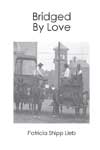
Historical novel good, fast read for summer afternoon
"Bridged by Love'
by Patricia Shipp Lieb
Reviewed by Bonnie Flouhouse
St, Anne, IL
Patricia Shipp Lieb's "Bridged by Love" is a historical novel set in Texarkana in the late 1880s. It's the story of two women--Shanna (a young Indian woman trying to evade ruthless white men) and Kathryn (a storng white woman willing to take on any opponent). Several people, but most importantly an infant, tie the women's lives.
The fast plot is at times too coincidental, but it ensnares the reader in the story of these women. To build suspense, the author presents segments of one character's story, stops at a crucial moment, and then moves to the other character's struggles.
Because the only way to connect Shanna and Kathryn is to show how several men are involed in their lives, several episodes involved only these men. Liberal doses of danger, treachery, intrigue, and romance fill the book.
Eventually Lieb untangles everyone and brings closure to the storylines. Numerous predictable stock characters add to the local color of the book: the slick swindler, the traveling prostitute, the ignorant guy who'll do anything for a few coins, the prejuciced business owner, the liberal man who thinks Indians are mistreated, the fiercely strong pioneer woman, the decent man who patiently waits for his chance at love, and displaced Indians. Add a ruthless tavern owner and a young man willing to face all foes for the woman he loves, and the character list is complete.
In an attempt to capture the aura and lifestyles of a past time, Lieb has crowded lost of characters and details into her book. But over all, "Bridged by Love" is a fast read good for a summer afternoon's enjoyment.
Bridged By Love by Patricia Shipp Lieb
Published Amazon.com
Description: Kathryn, a backwoods woman, and the young Indian girl, Shanna, have a connection: love for an infant. Set in about 1885, give or take, on the borders of Arkansas, Louisiana and Texas, with travels to the Indian Territory (now Oklahoma), complex characters tangled with kidnapping, murder and romance add a height of tension to this suspenseful telling of the difficult roads traveled between two women bridged by love.
Copyright 2006 (c) Patricia Shipp Lieb
Sunday, June 04, 2006
Tuesday, May 02, 2006
Across Texas from Home
Hey, don't let the photo fool you.
from this chicken pen in our back

(Fourth Grade in the 50s)
Try covering your face with a pillow while the West Texas winds stir furiously through the dusty lot and right through the thin window panes in a barely-room-to-move trailer when you are used to green grass and quiet stories in Texarkana. Odessa was certainly different and I never found my speech strong enough to call it home. I was just a kid during the days of the oil boom. Daddy was a roughneck and sometimes Mother tugged Paul, baby Gary, and me with her to the jobsite and we’d gaze at Daddy high up on a rig until he caught sight of the old faded-blue Dodge; and he’d back his way down knowing Mother had brought lunch. About every time we went to the oil fields, endless with stinky drillings going on, Mother had a fit and whined and demanded Daddy quit his job before he fell from the tall silvery straight-up mess of metal and left her with no support and three kids to feed. But Daddy being Daddy just said something like “Squaw, you’re crazy” and braced his teeth in the fried chicken thigh and ripped off hunks of greasy breaded skin as if he had never tasted the stuff before—back home in Texarkana we had a pen full of fryers to eat breakfast, dinner and at supper time.
Course, I don’t know what Mother did on days Paul, two years younger than me, and I had school. Speaking of school, I went to several during that short stay in that hot town I thought was surely out of America, even if it was somewhere in the middle of Texas. New schools were opening every day it seemed and I was constantly being switched—I don’t know, maybe according to the trailer-park address. Once I was the fifth Patricia in a fourth-grade class. When I was taken to the room and introduced to the teacher as “another new student” I got labeled “Patricia Ann.”
To more complicate my education, Mother decided I had to learn the steel guitar and signed me up for private lessons. The young male teacher didn’t teach me anything that I remember. He mostly just sat across from me in the closet-size hull used for a room strumming and singing something that made no sense to me and looking into space for the full forty-five minutes. I didn’t really like school then; but on Valentine’s Day a boy named Donnie whose blond hair grew half-way over his ears—not cool in the fifties—gave me a valentine, which made me very sad and upset with myself because I didn’t have a card for him. Before all the valentines got passed out, I quickly drew and cut one out and wrote the typical words, “I love you; be my valentine,” and handed it to Donnie. The prettiest best-dressed girls, who incidentally hung together, teased me about “claiming” the boy. “Patricia Ann claims Donnie, hee-hee.” Shoot, I didn’t even know they knew my name since hardly anybody talked to me unless it was to yell angrily: “kick the ball, kick the ball” when we were on the dusty field during outside p.e.
The trailer we lived in was so tight. Paul and I, and sometimes baby Gary, slept in a little bunk tucked in above the tiny dust-covered window; and our family shared restroom facilities and showers located in the middle of the trailer court with all who lived there, and even folks wandering in from the busy street somewhere out front. The space was cramped, to say the least. And we were so joyed when cold weather hit the desert and Daddy came home grinning and circling his finger in the air like a cowboy roping a calf through snowflakes as big as Texarkana plumbs. All he said was “Pack up.” Just once.
Next day we were scrunched in the old Dodge and headed HOME.. Was good to get back to Mrs. Buchanan’s’ fourth-grade class and listen to her read from the Bopsy Twins, where I didn’t have to share my name—I was just Patricia.
Copyright (c) 2006 by Patricia Lieb
Author of Bridged by Love
Tuesday, April 18, 2006
The weather is totally awesome on the Suncoast this time a year. And, let me tell you this, spending a day on Hernando County’s 12-mile long Weeki Wachee River is certainly worth bragging on. My friends and I went on a boating venture on a recent weekday while the river was un-congested.
We began our voyage at about 10 a.m. on a Tuesday morning and moved slowly upstream through a most awesome sub-tropical vegetation and perfectly clear waterway on Florida’s West Coast. We barely got going when we met a group of kayaks coming downstream. A girl about 6-years-old had the brightest lit face and her voice was totally joyous.
“A baby,” she says as our watercrafts meet. “A mother and a little bitty baby.” There was no mistaking her excitement. “Motorboats hurt manatees,” she said, knowingly. Running a motor is discouraged on the Weeki Wachee, however they can be rented at the Weeki Wachee Marina on Shoal Line Boulevard; marina management advises minimum speed, as the whole river, with a large portion being part of the Weeki Wachee Preserve, is “No Wake.”
“We’re barely moving and watching for manatee,” we assured the child. She kept smiling and chatting joy at seeing the manatees. As well as visitors, people living in this area take pride in the manatee. All along the residential shorelines, residents caution boaters to be aware that the river is a mother-baby manatee habitat.
In the clear Weeki Wachee—so named by the Seminole Indians meaning Little Spring, or Winding River—the manatee, which is a grayish-brown marine mammal that can grow to 13 feet and 2,000 pounds, can easily be seem through the water even when sleeping deep down. The Weeki Wachee, like Florida’s other inlets, serves as a home to these gentle mammals, as they spend winters in warm coastal waters, bays and rivers. According to statistic, some 2,500 manatees remain in the wild. However, this endangered specie is found in both salt and fresh water and feed on aquatic grasses.
Shortly after we maneuvered onto the meandering river and made a right turn, we almost lost our breaths as a large manatee showed itself above the water a couple times. My camera—where? Here. I grabbed it and snapped part of the glorious mammal before it ducked back into the current.
A relaxing trip up river and back allows people to see the manatee, as well as other wildlife: the abundance of plants, trees, turtles, birds and fish. I’m not kidding about seeing fish. Hugh fish. As we ventured slowly up the river toward Weeki Wachee Spring, we watched trout—surely a foot long—through the clear water as they meandered in schools around sand erosions. As well as manatee, this area is home to alligators, raccoons, otters and numerous birds. We easily spotted ibis, pelicans, herons, osprey, wood storks and cormorants.
The river took our breaths from the moment we moved slowly past small grand-fathered-in houses built decades ago in low-to-the-river fashion that would never pass state or county codes in coastal wetlands today. Now, areas so close to the Gulf of Mexico require storm protection that includes structures on stilts. Older structures here, house and few singlewide mobiles, are decorated in the river theme with mermaids, manatee, fish, and turtles statues; also palms, vines, plants and flowering gardens. Really can make a person want to relocate to this natured-filled habitat, curl up on a dock, and watch life go by. Of course, further down the river, a few new mansions and even some condos stand tall. Still, much of the area is nature preserve.
Moving on up river, I snapped photos of hanging orchids, palms in planters, various vines running up trees and out their branches and I even focused on sandbars covered by the clear river water. On the first two miles of our trip, we passed a developed area with housing on the north side of the river. As we approach the halfway mark, we saw two small beaches (about 1/2 mile apart) that made a great lunch stop. Here, a few people were bathing in the cool water.
On up river, several kayaks had stopped at the place the mother and baby manatees were spotted. Seeing them settled on the sandy river bottom in a sleeping fashion, we moved slowly on. Often people wading and swimming in the river actually get close enough to the manatees to touch them.
At 4.5 miles, the river enters Weeki Wachee Spring and Buccaneer Bay properties. During the 1990's, the company kept a few zoo animals and an injured bird recovery area along the river. Close to the spring, we met with a large sightseeing boat, and decided it was time to turn around a meander downstream. Had we continued on to the Weeki Wachee Spring attraction, we would not have been allowed to dock, anyway, as this area is private property now owned by the South West Water Management District.
People who know about Weeki Wachee Spring acquaint it with the Weeki Wachee Spring attraction, with the mermaid shows held 16 feet underwater. Surrounded by fish, turtles and— in the past—even manatee, the mermaids stay under the water with only air tubs while they put on 20-minute shows in the natural spring. People watch their performance from an underground theater. While mermaids perform, the spring current moves at 5-miles-per-hour as it discharges to the tune of more than 64 million gallons of 72-degree crystal-clear water a day.
The trip down river was faster than our journey up, as we were riding with the current. We passed Rogers Park, our starting point, and ventured further toward the Gulf of Mexico. We rode under Shoal Line Boulevard Bridge, by a residential area with grand-fathered-in houses close to the river and new mansion-like homes build up according to today’s code.
Here, seabirds are plentiful. Quicker than the mind can imagine, the vegetation changed from thick jungle-like greenery to tall sable palms, sawgrass marshland and gray barren trees colored black with cormorants and jeweled with silver tone osprey.
Finally, before finding ourselves in the gulf, we turned back and headed toward Rodgers Park and the Weeki Wachee Marina.
This wonderful river ride can be extended, as there are various waterways including a limb to Bayport, also to the Mud River confluence with the Weeki Wachee. Still, what we experience this day was awesome. We took in more nature in a few hours than many people see in a lifetime.
Copyright(c) Patricia Lieb 2006
Location:
The Weeki Wachee River and Weeki Wachee Spring Attraction & fun park Buccaneer Bay in Hernando County is some 55 miles north of St. Petersburg at US Hwy. 19 & SR 50. The 12-mile river begins at Weeki Wachee Spring and ends in the Gulf of Mexico. Canoes and kayaks can be rented at the spring; boats can be rented at the Weeki Wachee Marina on Shoal Line Boulevard. The facilities offer plenty spaces for parking..
Wednesday, April 05, 2006
Thanks Savannah Artist Chuck Hamilton
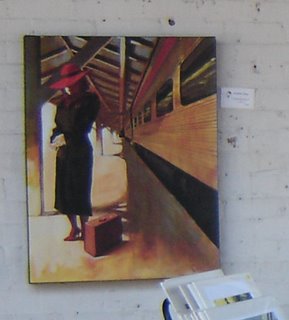
Love of Rails and Passengers
I love trains. The click-clanging wheels, the rocky ride, the elongated whistle. I think, read and write trains. This winter, in the City Market Place in Savannah, my eyes wandered the courtyard and suddenly focused straight to a painting of a woman standing by a train. This story now hangs in my Florida home. I know this traveler; the long-sleeved jacket and black dress below the knees, the red shoes and hat, and the tan-colored Staminate bag near her feet make me wonder.
Back in the ‘60s, I rode the rails lots, Kankakee to Texarkana to Kankakee. Changed trains in Memphis then crossed the Arkansas delta, empty bottomlands except for few unpainted shotgun houses occupied by sharecroppers.
Oh gosh, I’m not old as dirt, but let me tell you this: once I boarded a train in Memphis that must have come out of an old Roy Rogers movie. Honestly, I went to the club car, perhaps—it looked like a boxcar. Anyway, I drank coffee and smoked cigarettes. Watched a couple men play cards. Another with his pipe near what I’d almost swear was a wood-burning stove.
You know, this woman in the picture—I think she must be me. I think artist Chuck Hamilton was in that same club car, maybe he was drinking coffee, or playing cards, or warming his hands, or watching the cotton roll by—he surely was there, at least in his dreams.


